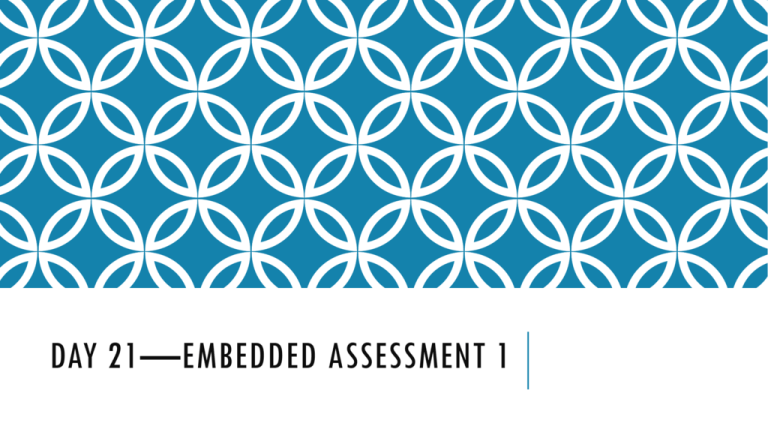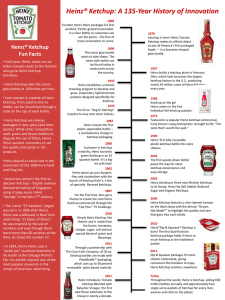Day 16*Embedded Assessment 1
advertisement

DAY 21—EMBEDDED ASSESSMENT 1 BELL RINGER We must forever conduct our struggle on the high plane of dignity and discipline. This sentence from the passage contains an example of A. alliteration B. hyperbole C. onomatopoeia D. personification ASSIGNMENT Write a reflective essay explaining your cultural identity. • Must be typed. • 1 ½ - 2 pages, double-spaced (don’t add space between paragraphs). • 12pt. (Calibri, Cambria, Times New Roman) • MLA Format *You have today and one full lab day to finish the essay. It will be due at the beginning of class on Day 18. Name Ms. Cable English 10 05 September 2014 Creative Title Be sure to indent the start of each paragraph and make sure your formatting is done properly. Don’t lose easy points! Also, remember that your thesis statement will generally be at the end of your introduction paragraph. RUBRIC AND GRADING • The grading rubric is on pg.46 in SpringBoard. Use this to help you write your essay. After all, this is how your work is being assessed! 1. Ideas a. Has a clear and maintained central idea (conflict/metaphor/central idea to focus the essay). b. Uses a range of well-chosen evidence to create a sense of cultural identity (hint: it may be a good idea to reference a text we’ve read). 2. Structure a. Uses an effective organizational strategy. b. Introduces ideas smoothly and links them logically. Contains a satisfying conclusion. c. Uses appropriate transitions RUBRIC AND GRADING (CONT.) 3. Use of Language a. Uses precise and appropriate language to create a distinctive tone and voice. b. Uses various types of phrases to convey or add variety and interest. c. Demonstrates strong command of grammar, usage, capitalization, punctuation, and spelling. **40 summative points (weighted at 60% of grade) **Due at the beginning of class on Day 18. CULTURAL ELEMENTS •Race •Sports •Ethnicity •Politics •Religion •Language •Music •Community •Fashion •Gender •Food • Family •Hobbies •Nationality QUESTIONS TO CONSIDER 1. What kind of tone do you want to have in your essay? 2. What cultural elements have influenced who you are the most? Could you use one of these as a metaphor? 3. How does your cultural identity compare to that of your parents, peers, or even strangers? 4. Think about the texts we’ve read (“What is Cultural Identity,” “Ethnic Hash,” “Two Kinds,” “By Any Other Name,” “Multi-Culturalism-HAPA”). Could you relate to any of these texts or use them to support your writing? 5. We have analyzed conflict in several texts now. Can you think of any internal or external conflicts that have shaped your own cultural identity? EXEMPLARY ESSAY EXAMPLE INTRO The Discarded When my classmates talk about “culture,” I wonder if it means people who look the same, or who speak the same language, or who go to the same places to worship, or who enjoy the same music and the same foods. When people talk about sports, or music preference, or their favorite breed of dog, as their “culture,” I wonder if they are talking about the things that bring them closer to others or divide them from the rest of the rabble and set them apart. It seems that “culture” and the aspects we use to define ourselves can be used both to unite us and divide us. EXAMPLE EVIDENCE But really, my culture is an international culture. And my society is the company of people who care about others. My orphanage, Shepherd’s Field, was run by Chinese and American missionaries. They felt that if this problem with my heart could be corrected, I was much more likely to be adopted. Shepherd’s Field managed to raise enough money so a surgeon could fly into China and perform a surgery to fix my heart. When I was adopted out to America, I was five years old, but I was so small my first two years were in preschool. I entered kindergarten just before I turned seven. EXAMPLE CONCLUSION My father is a toymaker, though that obviously isn’t his real job in the Marines. When he first came home from deployments, he’d spend time in the shed out back of our house which he’d made into a toy factory and spend an hour or two after dinner each night working there. Often my Dad preferred to be alone, but sometimes he’d let me come in and help him with sawing, sanding, drilling, and painting. It was like magic to see these unformed blocks of wood slowly get transformed from the discarded he picks up from Home Depot and local furniture stores to ducks with wheels, rubber-band powered cars, and other things. These toys would be sent back to China every December for Christmas. Wood toys last a long time in an orphanage. They can survive when battery-powered toys break. That’s how I saw myself, in the beginning, like those blocks, plucked out of a discard pile of loose wood that nobody wanted. But that’s not how I see my culture now—less unformed wood and more like what’s revealed by cutting away all the excess stuff. Being Chinese-American is the least important thing about me. My job is to do well in school and maybe, perhaps some day, give back what has been so freely given to me. Until then, I can continue to learn my culture, just in case I want to be a surgeon, or a train conductor, or a sea captain, or a soldier, or a toymaker. PROFICIENT EXAMPLE FIFTY-SEVEN VARIETIES While it’s difficult to break down my culture into only a few elements, being a Creole I’d say it comes down to my hair, my music and food. First, the term “Creole” means I’m mostly French-Vietnamese, but I’m also part-black and part-Mexican and part-Samoan. Some people might say that “Creole” is kind of worthless phrase, like a mutt. That’s to put it bluntly. I prefer to think of “Creole” as like Heinz Ketchup: there’s fiftyseven varieties of us, we can be found everywhere, and we’re good with everything. Since LA is such a multi-racial city, there are many different ethnic groups, from Mexicans to Filipinos to Iraqis, and we all have to fill in that same bubble on the tests, to break us down further in to “halves” or “eighths” of anything seems insulting. I’ve learned to embrace my cultural uniqueness though because, outside of LA, people still think of me as “exotic”—not really fond of that term—and ask me “what are you?”. Rather than get mad, I’ve come to think it’s an opportunity to educate them because the question usually comes out of ignorance, not meanness. Usually. Like I said with ketchup, there’s fifty-seven varieties of Creole. I’d like to also think there’ fifty-seven ways to be Creole. Being of two cultures, I can usually navigate between the West Coast, intense lifestyle of LA and the more laid-back values of Hawaii. No, I don’t surf, but I do stand-up paddleboard. Yes, I can dance the aloha, but I just as much enjoy going out to dance to house and trance and techno music in West LA venues. No, I’ve never met Don Ho, but I plan on going to a Jack Johnson concert this summer in San Diego; one of the first reasons I learned to play guitar was to play “Bubbletoes”. Yes, I’m good at math, but I’m also good a lot of other things: I’m on track to earn my black belt in Kenpo this summer, which I’ve practiced since I was nine, so, yes I’m Asian-looking and I’m also good at martial arts, but I gotta also tie back my Fro. When people look at you a certain way, they seem to want to funnel your talents into little bottles so they can put you up on a shelf and categorize you. I refused to categorized on a shelf, which is why I plan to get my own place at the table—like Heinz ketchup. CONT. My mother, Alaina, was born and raised as French Polynesian island girl out in Oahu until she met my father, who was in the military. She was working as a waitress off base and he was an officer and he’d come into her restaurant, always sit at the same table, always order the same dish: scrambled eggs with a side of SPAM, which is spiced pork and ham, alongside a traditional dish of poi, which is crushed tarot root. SPAM is really popular with the locals since WWII and they put in everything, from sandwiches to soups. My father was trying to eat the local recipes, he said, to impress my mom with his really bad French. She pretty much saw right through it, but the thing she says stuck in her mind was how much ketchup my father put on everything, a trait I have inherited. My mother tells me now that when they started dating, her family—especially my grandfather was really resistant because my father wasn’t a local boy—a Vietnamese boy from San Diego. But my father persisted and even started going over to the house and raved and raved about my grandmother’s food, and he started to gain weight as he dated my mom. My Dad sometimes joked that he had to marry my mom or get kicked out of the Air Force because he couldn’t fit in the planes cockpit anymore! The story of my parents is like the story of ketchup, because it can be found everywhere an American serviceman is stationed around the world, meets a local girl and falls in love with her. Thirdly, the way I’m like Heinz ketchup is my hair: thick, wooly, and “kinky as a bedspring”. It’s been a source of pride and shame, frustration and hope my entire life. When I was a little girl going to school in Hawaii, other kids gave me a hard time about it because, despite my oval face and almond eyes, it so clearly showed that I wasn’t Hawaiian. I’d tie it back and put it up in a bun and basically try to ignore, but there was no ignoring my curly head of hair in the wind and heat and humidity of Oahu. My mom tried help me tame it, so we tried a lot of different conditioners and treatments to make my hair “behave,” but by the end of the day it was always this billowy, frazzled mess pouring out over my collar. People teased and I hated school because there was no way to hide it other than a kerchief. I pretty much settled on two tight buns all throughout elementary school. When I got to LA, when my dad retired from the military, there were some Samoan girls at my school—they had even bigger hair than I did! But they also took me under their wing and we hung out a lot on the boardwalk, so I saw the incredible variety of people. Also, being SaMo [Santa Monica], pretty much everyone has messed-up hair on the boardwalk, so it wasn’t that big of a deal. With my homegirls, I learned how to dance to the music I liked, introduce them to different foods, and they accept me and my crazy family. The great thing about LA is that there’s a Denny’s on every corner, and at every table a Heinz ketchup bottle, so wherever I go, I feel like I’m at home.



